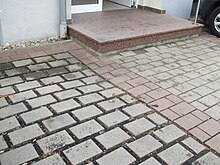Settlement (construction)

In civil engineering and in geosciences, settlement is understood to mean the slow subsidence of a structure or a rock body through gradual compression ( compaction ) of the subsoil.
Are to be distinguished
- Settlement of a new structure by soil pressure
- Settlement of loosened and reinstalled soil; even without load
- Large-scale uplifts and subsidence due to geological processes or as a result of mining
- Subsidence for another reason
Building settlement
Almost any loose rock can be compressed, as pore volume can still be compressed or soil particles can better fill the cavities through relocation. Almost every floor will, however, partially expand again when the load is removed, but not to the volume before the load.
Soils are usually the result of sedimentation or the weathering of rock. It follows from both processes that undisturbed soil does not have the highest storage density. The highest load that undisturbed soil experienced was due to the ice load during the last ice age .
When building a heavy structure, subsidence occurs, as a result of which the structure sags by a few centimeters, and rarely even decimetres. The subsidence usually occurs during construction and often only gradually subsides after several years, depending on the nature of the subsoil. In cohesive soil , the subsidence takes longer than in non-cohesive soil types . The settlement can be approximately calculated in advance after assessing the soil. Their height depends not only on the size of the load, but also on the type of soil structure. Structural settlements are always problematic when there are different types of soil in the subsoil distributed over the floor plan. This can lead to different settlements, possibly also to misalignment. It is also problematic when two structures are built one after the other and connected to one another. The different settlement processes over time can lead to damage. This can be remedied by providing joints between the structure or other structural measures. An improvement in the subsoil or a deep foundation can reduce the settlement.
Loosened soil
If soil in the form of loose rock is excavated as part of a construction project and stored on the side, then it experiences a loosening through this process (disturbed soil), which often includes an increase in volume of 30%. If this floor is reinstalled without further measures, a volume reduction of roughly similar dimensions will occur over the next few years. This settlement can persist for several centuries in dams .
Soil compaction provides a remedy by using appropriate machines to largely compress the soil by means of shaking, vibration and loading. Installation in layers of a few decimeters and then intensive compaction with z. B. vibratory rammer or other compacting equipment . Since this work is time-consuming and difficult to monitor by the client, there are relatively often construction defects . Carrying out a plate pressure test after soil compaction gives good information about the quality of compaction.
In the case of smaller construction measures, compaction is also dispensed with. For this reason, a burial mound is first heaped up in the case of graves or a waiting period is observed when building new houses. Only then do further construction measures (e.g. grave borders, garden sheds, paving, setting of fence foundations, greening, path construction) make sense so that cracks and tilts do not arise as a result of subsidence.
special cases
- Subsidence can also arise from vibrations in the ground, for example from traffic.
- In the case of very soft soils, the subsoil may evade due to lateral earth pressure (see also settlement flow ), due to additional loads (e.g. snow pressure) or relief (e.g. excavation on a neighboring property)
- Changes in the water content in the soil and subsequent volume reduction through drying out and other shrinking processes,
- Groundwater subsidence very often causes subsidence , even in undisturbed soils, as the soil previously in the groundwater was buoyant and only now develops its full weight.
monitoring
Large technical structures such as large buildings, heavy or high bridges , power plants, dams and dams are mostly monitored by long-term settlement measurements. Periodic height measurements or leveling are carried out by geodesists, which are carried out from geologically stable points . In the case of dams, these are several points in the adjacent rock , but at a greater distance from the abutments . The measurements can also take place automatically (with computer tachymeters ) and - for example if there is a risk of landslides - be coupled with a warning or alarm system.
In addition, geotechnical measuring sensors are often integrated into the structure in large structures - such as strain gauges , temperature and electrical sensors - in order to automatically detect small changes. Periodic measurements in the inspection corridors are also required in dam walls. In active and abandoned mines , possible subsidence above the cavities and tunnels is to be expected, even if these are several hundred meters below the surface of the earth. At coal and steel and technical universities , these phenomena are investigated in the specialist areas of mining damage and mine surveying.
literature
- Hans Murawski: Geological Dictionary . Ferd. Enke Verlag, Stuttgart 1998, ISBN 3-432-84100-0 .
- Heinz Brandl : Geotechnics . Script for the lecture, TU Wien / Foundation and Soil Mechanics ~ 1995.
- B. Ullrich: Interaction between subsoil and structure. on: www.tu-dresden.de (250 kB; PDF)
Web links
Individual evidence
- ↑ Karl Terzaghi, Ralph B. Peck: The soil mechanics in the building practice. translated into German by Alfred Bley. Springer Verlag, Berlin / Göttingen / Heidelberg 2013, ISBN 978-3-540-02758-4 , p. 557. ( limited preview in the Google book search).
- ^ KJ Witt: Non-mining causes of settlement damage to buildings. Lecture at the Bergschadensforum 2014. PDF file , company website.
- ↑ Helmut Prinz: Engineering Geology. Springer-Verlag, 2012, ISBN 978-3-8274-2473-0 , p. 226. ( limited preview in the Google book search).

